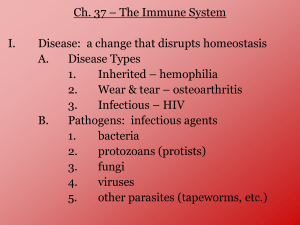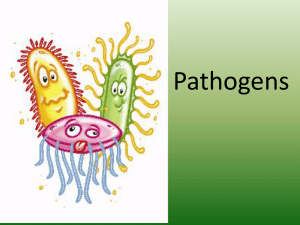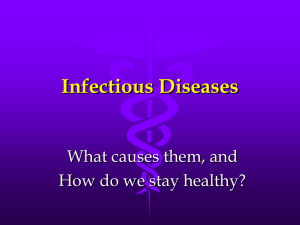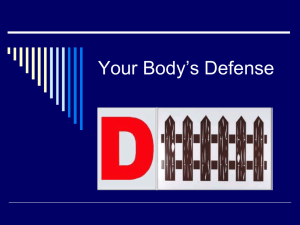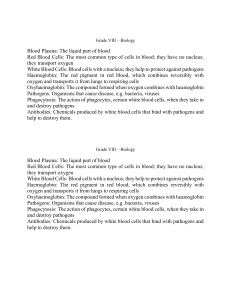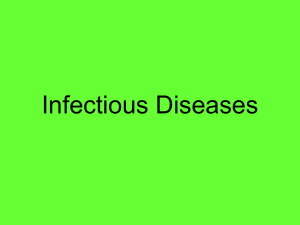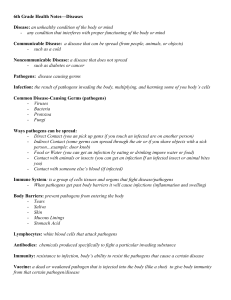Your Immune System
advertisement
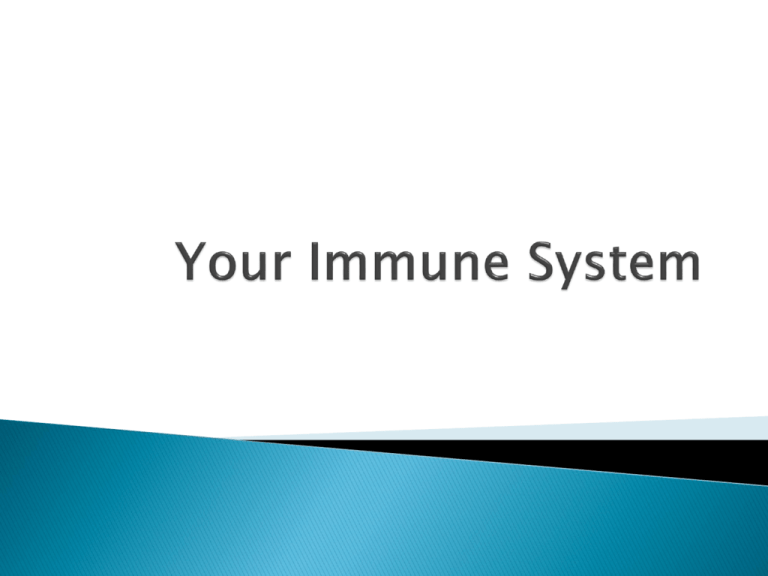
Disease- any change, other than an injury, that disrupts the normal functions of the body Pathogens- disease-causing agents ◦ ◦ ◦ ◦ ◦ Bacteria Viruses Fungi Environmental agents Inherited agents Viruses- tiny particles that invade and replicate within living cells ◦ Take over many of the functions of the host cell ◦ Common cold, influenza, smallpox, and warts Bacteria- single-celled organism that lacks a nucleus ◦ Some are harmless to humans ◦ Cause diseases by breaking down the tissues of the infected organisms from food or by releasing toxins that harm the body ◦ Streptococcus infections, diphtheria, botulism, and anthrax Protists- eukaryote that is not a plant, animal or fungus ◦ Malaria- caused by Plasmodium spread by mosquitos ◦ African sleeping sickness- caused by Trypanosoma, which lives in the bloodstreams of vertebrate animals ◦ Amebic dysentery- caused by Entamoeba, located in contaminated water supplies Worms- flatworms, roundworms, tapeworms, and hookworms ◦ Schistosoma- a flatworm infecting people working in rice fields Fungi-obtain energy from dead, organic matter ◦ Tinea- athlete’s foot and ringworm ◦ Others can infect the mouth, throat, fingernails, and toenails First line of defense ◦ Skin- most important barrier ◦ mucus- lines nose and throat and helps to trap pathogens ◦ Oil and sweat glands- produce an acidic environment that kills many bacteria ◦ Tears- protect eye openings ◦ Saliva- protects mouth opening ◦ Cilia- line nose and throat and help to push pathogens away from lungs ◦ Stomach acid and digestive enzymes- destroy many pathogens that make their way to your stomach 2nd line of defense ◦ Inflammatory response- a nonspecific defense reaction to tissue damage caused by injury or infection White blood cells multiply; blood vessels expand; phagocytes (WBC) engulf and destroy bacteria Fever- elevated body temperature Important because many pathogens can survive only within a narrow temperature range ◦ Interferon- proteins that help other cells resist viral infections Function: inhibit the synthesis of viral proteins in infected cells and help block viral replication Includes lumph nodes and lymph fluid. Lymph fluid is blood plasma (liquid that makes up the blood minus the red and white cells). Bacteria or other pathogens that enter the body find their way into this fluid, which is filtered through the lymph nodes. The lymph nodes then filter the fluid and remove these dangerous particles. These lymph nodes may swell when fighting an infection, hence you can feel those bulges at your neck when you're sick. The Thymus - this organ lays between your breastbone and your heart. It is responsible for making T-cells. Spleen - filters blood and removes any foreign particles and old blood cells in need of replacement. A person missing a spleen may get sick more often than one without a spleen Bone Marrow - produces new blood cells, both red and white. The bone marrow produces all blood cells from STEM CELLS, which mature into different types of white blood cells. White Blood Cells - also known as Leukocytes ◦ Neutrophil - suicide bomber cells that destroy cells infected by a virus ◦ Macrophages - consume pathogens ◦ B Cells - mature into plasma cells when stimulated ◦ Plasma Cells - produce antibodies specific to an invader ◦ Cytotoxic (Killer) T Cells - bump into infected cells, poke holes in them and destroy them ◦ Helper T Cells - activate Killer T cells and B cells collectively called phagocytes -- converge on the invaders and proceed to literally "eat them up." Generally the phagocytes will build up in one place, causing what we call puss -in order to eliminate the waste. Antigens are substances that trigger an immune response. Cells infected by viruses displace antigens on their surfaces. These antigens are recognized by other cells. Antibodies are the bodies best defense against viruses. However, antibodies are specific in their actions, that is that a chickenpox antibody will only attack a chickenpox virus. Thus a particular virus stimulates the production of a particular antibody.
